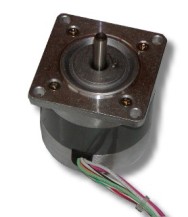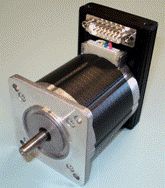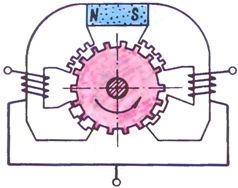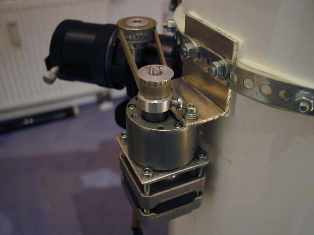Categories: Interesting Facts, Novice electricians
Number of views: 69046
Comments on the article: 0
Stepper motors
 More recently, the term stepper motor was known only to a narrow circle of electrical engineers. Now, stepper motors have received the honorable right to be called only by their "initials" - SD evidence of the widespread use of electrical machines of this type.
More recently, the term stepper motor was known only to a narrow circle of electrical engineers. Now, stepper motors have received the honorable right to be called only by their "initials" - SD evidence of the widespread use of electrical machines of this type.
Imagination involuntarily prompts the image of a stepping electric machine with limbs. No, this is not a robot, although a stepper motor can control one of its joints. The car itself is very simple. A stepper motor can be represented in the form of several electromagnets with pulse windings on a fixed part (stator) and an armature, which, when switching the windings, rotates or moves progressively. To understand how a stepper motor works, remember the principle of operation of other electric machines, such as synchronous.
There are two or three windings on the stator. They are flowed around by smoothly changing sinusoidal currents. Together with the current, the electromagnetic field pulsed by each winding pulsates. The currents in the windings do not rise and fall simultaneously, but with a strictly defined time delay; the windings themselves are shifted relative to each other and occupy evenly alternating sections of the cylindrical surface.
Due to this, two or three pulsating field waves (according to the number of windings) form one traveling wave. For each cycle of a complete change in current in the windings, the resulting wave runs around the entire cylindrical surface of the stator bore or part of it. The field rotates evenly, carrying the rotor along with it. The currents in the windings change continuously, so the field in the working gap and the rotor rotate continuously. The movement consists of many infinitely small displacements.
And if at some point you stop the currents changing, freeze them at the achieved level, anyway, which, like in the cinema, show the same frame for some time? Together with the currents in the windings, the wave of the traveling field will freeze in some position, and with it the rotor will stop. Let’s change the group of frames and stop the last one again, the rotor will turn a certain angle and will freeze again.
 Repeat this again and again. The car obediently walked in steps. It turned out to be very simple to change currents in windings with large or small jumps, freezing the process on any frame. It is enough to apply steps of rectangular pulses to the windings instead of continuously changing voltages. Each impulse is a step, and it can be delayed, if desired, to infinity, that is, stop the process and lock the rotor. While the pulses alternate slowly, the engine strides distinctly.
Repeat this again and again. The car obediently walked in steps. It turned out to be very simple to change currents in windings with large or small jumps, freezing the process on any frame. It is enough to apply steps of rectangular pulses to the windings instead of continuously changing voltages. Each impulse is a step, and it can be delayed, if desired, to infinity, that is, stop the process and lock the rotor. While the pulses alternate slowly, the engine strides distinctly.
Our eye is able to distinguish several tens of steps per second. But the frames flashed: a hundred, two hundred, a thousand, several tens of thousands of steps per second. Not only our eyes, but also sensitive instruments no longer distinguish steps, but simply see rotation.
The stepper motor runs, as before, though swaying a little, because it takes every next step strictly at the time of the arrival of the next command, and this moment may not be the most convenient. The internal automatism of movements is destroyed and replaced by blind obedience to the team. But at any moment, at any step, we can order: "Freeze!". The rotor will swing and freeze exactly in the indicated position.
Try moving him forcibly when there is no team. He will resolutely resist, and if the engine is of a decent build, you won’t take it with your bare hands. The electromagnetic field does not want to part with the rotor, either in motion or at rest. It is it that holds him in his tenacious embrace and makes him repeat all his step movements.
Incidentally, the “stitching” of individual steps, and if you like, of elementary cycles or cycles of motion into an infinite sequence, which we perceive as continuous rotation with slightly noticeable pulsations of speed, occurs in a direct current machine in the same way as in an internal combustion engine. Only there, the role of tireless operators are not brushes, but electric candles.
The field steps, because the electronic keys are opened by commands from the outside, then they prohibit the access of current to the windings. The stepper motor is powered by an electronic brain, and its capabilities become exceptional, sometimes immensely.

Schematic diagram of a single-phase stepper motor with a symmetrical magnetic system for watches, counters and industrial automation devices.
CNC stepper motor
Modern technology is inconceivable without milling, turning, EDM and many other digitally controlled machines. Most of them operate thanks to stepper motors.
Stepper motors settled in the control mechanisms of rolling mills, presses and other metallurgical machines, became one of the most common elements of automation, work in electric clocks, timers and counters, on ships, planes and artificial Earth satellites - wherever fast, accurate and reliable is required fulfillment of the will of man.
With the expansion of the working professions of the stepper motor, an independent developed direction arose - discrete electric drive with stepper motors. Its origins were scientists and engineers of the problematic laboratory of electromechanics MPEI.
The stepper motor won the first victory in 1957, when the world's first Soviet digitally controlled milling machine was exhibited at the World Exhibition in Brussels, where various interesting exhibition stands were presented. This exhibit was awarded the Big Gold Medal and opened a new page in machine tools.
Boris Ivobotenko, Doctor of Technical Sciences
See also at bgv.electricianexp.com
:

